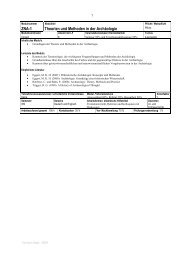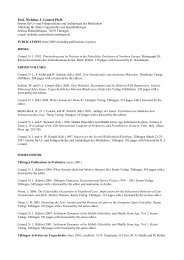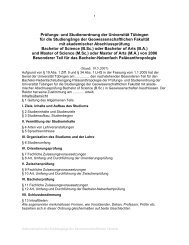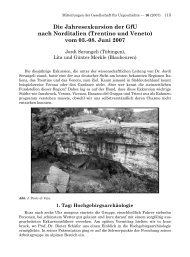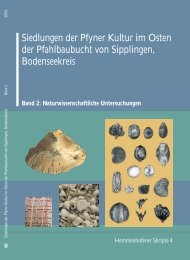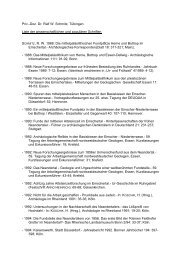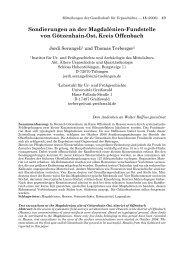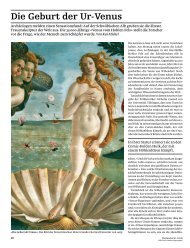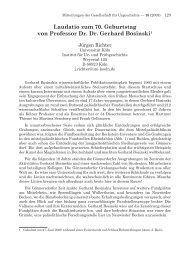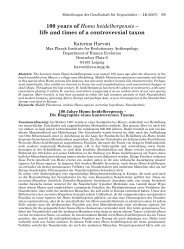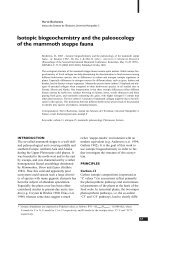bronze age environment and economy in the troad - Universität ...
bronze age environment and economy in the troad - Universität ...
bronze age environment and economy in the troad - Universität ...
You also want an ePaper? Increase the reach of your titles
YUMPU automatically turns print PDFs into web optimized ePapers that Google loves.
chapter 2: methods<br />
mistaken sample amongst a total of 10 samples results <strong>in</strong> an<br />
error of 10%, whereas <strong>the</strong> same sample amongst a total of 344<br />
samples results <strong>in</strong> an error of only 0.29%.<br />
To exclude multiple sampl<strong>in</strong>g, <strong>the</strong> raw data were exam<strong>in</strong>ed for<br />
<strong>the</strong> orig<strong>in</strong> (co-ord<strong>in</strong>ates) of <strong>the</strong> samples, <strong>and</strong> on <strong>the</strong> sample<br />
composition of neighbour<strong>in</strong>g samples. Except for pits filled by<br />
clearly dist<strong>in</strong>guishable events, samples from neighbour<strong>in</strong>g<br />
locations which showed <strong>the</strong> same composition <strong>and</strong> <strong>the</strong> same<br />
proportions of species or categories were summarised as one<br />
sample.<br />
The percent<strong>age</strong> occurrence of specific plant groups (e.g. crops)<br />
with<strong>in</strong> different periods gives an impression of dom<strong>in</strong>ance or<br />
underrepresentation of each species. Dom<strong>in</strong>ance with<strong>in</strong> <strong>the</strong> set<br />
of analysed samples should not be confused with <strong>the</strong> mean<strong>in</strong>g<br />
of “importance”, which would be an “unjustified assumption<br />
that numerical values reflect importance” as G. Jones (1991)<br />
po<strong>in</strong>ted out (for earlier discussions see also Dennell 1976). But<br />
at least percent<strong>age</strong> occurrence provides a clear pattern of <strong>the</strong><br />
<strong>in</strong>crease or decrease of ubiquities of s<strong>in</strong>gle species from one<br />
period to ano<strong>the</strong>r.<br />
The percent<strong>age</strong> occurrence of some of <strong>the</strong> crops was calculated<br />
for <strong>the</strong> sequence Kumtepe, Early Bronze Age Troy, Middle<br />
Bronze Age Troy, Late Bronze Age Troy, Post-Bronze Age<br />
Troy <strong>and</strong> is presented <strong>in</strong> Graph 45.<br />
2.2.2.3 Multivariate methods<br />
Accord<strong>in</strong>g to G. Jones (1991) <strong>the</strong> two ma<strong>in</strong> approaches with<strong>in</strong><br />
statistical analysis are ‛pattern search<strong>in</strong>g’, where group<strong>in</strong>gs of<br />
<strong>the</strong> data are sought <strong>and</strong> ‛problem-oriented analysis’, where<br />
ra<strong>the</strong>r complicated analyses f<strong>in</strong>d application. The different k<strong>in</strong>d<br />
of analyses <strong>in</strong> this work were ma<strong>in</strong>ly used for ‛pattern<br />
search<strong>in</strong>g’.<br />
For <strong>the</strong> preparation of <strong>the</strong> <strong>in</strong>put files, those samples were<br />
chosen that were assumed to be representative of <strong>the</strong> sampled<br />
context, i.e. that had more than 50 records (van der Veen<br />
1992). Fifty-seven percent of <strong>the</strong> orig<strong>in</strong>al number of samples<br />
were excluded. A method of reduc<strong>in</strong>g <strong>the</strong> volume of data by<br />
reduc<strong>in</strong>g <strong>the</strong> number of categories (taxa) has been worked out<br />
by van der Veen <strong>and</strong> Fieller (1982). They have calculated <strong>the</strong><br />
number of items required to estimate relative quantities at<br />
different levels of accuracy <strong>and</strong> confidence, for different sizes<br />
of parent population. For <strong>the</strong> cut-off po<strong>in</strong>t of species<br />
represented <strong>in</strong> <strong>the</strong> Troy <strong>and</strong> Kumtepe samples, ubiquities of<br />
more than 10% were chosen. This lies with<strong>in</strong> <strong>the</strong> range (5-<br />
20%), assumed to characterise rare species <strong>in</strong> community<br />
ecology (Gauch 1982a, <strong>and</strong> 1982b, Lange 1990), <strong>and</strong> reduces<br />
<strong>the</strong> number of species categories from 318 to 94, i.e. 266714<br />
seeds or 98,8 % of <strong>the</strong> total amount of seeds.<br />
Samples or species below <strong>the</strong> threshholds mentioned were<br />
omitted from <strong>the</strong> multivariate analysis <strong>in</strong> order to conduct <strong>the</strong><br />
necessary data compression. No o<strong>the</strong>r manipulation of <strong>the</strong> data<br />
was necessary to apply Canoco.<br />
Canonical discrim<strong>in</strong>ant analysis is used to discover those<br />
variables that best discrim<strong>in</strong>ate between groups, thus allow<strong>in</strong>g<br />
ungrouped units to be assigned to <strong>the</strong>m (Pearsall 1989). It starts<br />
from <strong>the</strong> assumption that a set of objects (species) belongs to<br />
more than two groups (crop-process<strong>in</strong>g st<strong>age</strong>s), i.e. that <strong>the</strong><br />
group to which an <strong>in</strong>dividual belongs is known. “L<strong>in</strong>ear<br />
comb<strong>in</strong>ations of <strong>the</strong> variables are sought that display <strong>the</strong><br />
difference between <strong>the</strong> presumed groups as clearly as possible.<br />
The aim may be to confirm that <strong>the</strong> presumed groups are<br />
<strong>in</strong>deed dist<strong>in</strong>ct or to provide a criterion for allocat<strong>in</strong>g<br />
unclassified <strong>in</strong>dividuals to a group” (Baxter 1994, p. 186).<br />
Canonical discrim<strong>in</strong>ant analysis was used to determ<strong>in</strong>e cropprocess<strong>in</strong>g<br />
st<strong>age</strong>s. The problems of compar<strong>in</strong>g samples without<br />
know<strong>in</strong>g <strong>the</strong> st<strong>age</strong> of crop-process<strong>in</strong>g <strong>the</strong>y come from are<br />
po<strong>in</strong>ted out by Jones (1983a, 1983b <strong>and</strong> 1984) <strong>and</strong> Hillman<br />
(1984a <strong>and</strong> 1984b). The statistical method to detect cropprocess<strong>in</strong>g<br />
st<strong>age</strong>s, was worked out by Jones (1987a, 1987b),<br />
<strong>and</strong> is based on ethnographic research <strong>in</strong> Greece (Kolofana).<br />
Samples from traditional crop-process<strong>in</strong>g were analysed for<br />
characteristics that best dist<strong>in</strong>guished between <strong>the</strong> known<br />
groups. New variables were def<strong>in</strong>ed (discrim<strong>in</strong>ation). The four<br />
groups of rema<strong>in</strong>s that result from traditional crop-process<strong>in</strong>g<br />
are: w<strong>in</strong>now<strong>in</strong>g by-products, coarse-sieve by-products, f<strong>in</strong>esieve<br />
by-products, <strong>and</strong> f<strong>in</strong>e-sieve products. The characteristics<br />
that best dist<strong>in</strong>guish between <strong>the</strong> known groups (new variables)<br />
are comb<strong>in</strong>ations of three morphological characters of <strong>the</strong> weed<br />
seed. The characters are seed size (Big/Small), ‛headedness’<br />
(tendency of seeds to rema<strong>in</strong> <strong>in</strong> heads dur<strong>in</strong>g crop-process<strong>in</strong>g,<br />
ra<strong>the</strong>r than to be dispersed (Free/Headed)), <strong>and</strong><br />
‛aerodynamics/lightness’ (Heavy/Light). The comb<strong>in</strong>ations of<br />
<strong>the</strong>se three characters <strong>in</strong> one weed species lead to six overall<br />
categories of weed taxa, <strong>the</strong> new variables (see appendix 4,<br />
CPS). The application of <strong>the</strong> new variables to <strong>the</strong> whole set of<br />
species leads to <strong>the</strong> allocation of <strong>the</strong> samples to <strong>the</strong> four cropprocess<strong>in</strong>g<br />
st<strong>age</strong>s.<br />
The potential weed species of Troy samples were assigned to<br />
categories. The analysis was run <strong>and</strong> plotted to Jones’ Kolofana<br />
data with SPSS. The results are <strong>in</strong>cluded <strong>in</strong> chapter 5 (see<br />
Graph 41).<br />
With <strong>the</strong> calculation of <strong>in</strong>dividual correlation coefficients, <strong>the</strong><br />
strength of a relationship between <strong>the</strong> values of two variables<br />
(species) can be ascerta<strong>in</strong>ed. Over <strong>the</strong> whole set of samples <strong>the</strong><br />
values of one variable (species) are compared with those of <strong>the</strong><br />
second variable (species). If <strong>the</strong>re is any relationship between<br />
<strong>the</strong> values of <strong>the</strong> variables, i.e. if <strong>the</strong> variables vary toge<strong>the</strong>r,<br />
<strong>the</strong>y are correlated. To visualise <strong>the</strong> strength of a correlation<br />
one might imag<strong>in</strong>e a plot, with <strong>the</strong> values of one variable on<br />
<strong>the</strong> x-axis, <strong>the</strong> values of <strong>the</strong> o<strong>the</strong>r variable on <strong>the</strong> y-axis. The<br />
samples (cases) would be <strong>the</strong> reference po<strong>in</strong>ts <strong>in</strong> <strong>the</strong> plot. The<br />
plotted po<strong>in</strong>ts would lie for a perfect correlation on an<br />
imag<strong>in</strong>ary straight diagonal. Usually correlations are weaker.<br />
The degree of correlation, or <strong>the</strong> closeness with which <strong>the</strong> pairs<br />
of values fit a straight l<strong>in</strong>e, is numerically expressed by <strong>the</strong><br />
correlation coefficient (r). The st<strong>and</strong>ard error of <strong>the</strong> correlation<br />
coefficient is a measure for <strong>the</strong> significance of <strong>the</strong> correlation<br />
coefficient. In <strong>the</strong> analyses conducted here a probability level<br />
between p=0.00 <strong>and</strong> p=0.02 was chosen. The st<strong>and</strong>ard error<br />
p=0.02 means that <strong>the</strong>re will appear to be a significant<br />
correlation <strong>in</strong> 2% of <strong>the</strong> tests, even if <strong>the</strong>re is no actual<br />
correlation between <strong>the</strong> variables. This factor could only be<br />
excluded by tak<strong>in</strong>g p=0.00, but <strong>in</strong> this case one would have to<br />
exclude too many very probable actual correlations.<br />
21




